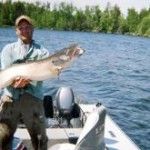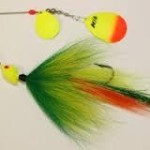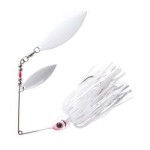by Daniel Quade
from The Fishing Wire
Muskies are fabled as fish of 1,000 casts, but fall is a great time to cut that imposing figure down to size. In fact, anglers keying on high-percentage hotspots with the right tactics can enjoy the best muskie fishing of the year.
Whopper muskies like this one don’t necessarily take 1,000 casts to catch, but they do take the sort of expertise offered by top guides like Bill Rosner.
Veteran muskie guide Bill Rosner might not be a math whiz, but he’s an expert at subtracting sizeable sums from the mythical 1,000-cast mark. He follows environmental clues to craft a milk run of prime locations where he can consistently put clients on toothsome trophies, then deploys proven presentations to tempt these freshwater monsters into striking.
“In late summer, muskies are scattered all over the place,” begins the jovial yet hard-fishing guide, who cut his teeth in northern Wisconsin but now calls Minnesota’s legendary Lake Vermillion his home waters. “You find them on rock reefs, rocky points, deep weed edges-here, there and everywhere-wherever forage is available. Find food, and you find muskies.”
As the water temperature begins to drop in September, however, some of the more fragile varieties of aquatic vegetation start to wither away, pushing muskies to the last remaining stands of greens. On Vermillion, that’s cabbage beds.
Also known as broad-leafed pondweed, cabbage is hearty, often remaining healthy long after other plants have expired. Its leafy stalks offer shelter for a number of forage species, which also flock to the season’s last stands. The abundance of forage does not go unnoticed by a lake’s predatory population-including behemoth muskies.
On Vermillion, Rosner typically targets beds in 6 to 12 feet of water, though he notes that the depth of vegetation varies from lake to lake depending on water quality. In clear lakes it’s not uncommon for cabbage to take root in depths of 20 feet. Other top late-season greenery includes northern milfoil, but the important thing is finding the best remaining weedbeds after other stands have fallen.
The Lindy Muskie Tandem is among the prime lures for giant muskies in September.Rosner raids these fish-holding sunken gardens by slinging blades-specifically, a Lindy M/G Muskie Tandem. The 1-ounce, 9½-inch double-bladed spinnerbait sports size 5 and size 8 Colorado blades that churn and flash, attracting hungry muskies and triggering strikes the likes of which are hard to match in freshwater. Color selection is simple.
“Bright day, bright lure; dark day, dark lure,” Rosner said. “There’s nothing wrong with downsizing, either.”
He sometimes throws a ½-ounce spinnerbait like Booyah’s Pikee with a soft-plastic trailer, either the YUM Boogee Tail or Houdini Shad. His standard tackle for taking on giant muskies consists of an 8-foot, medium-heavy casting rod loaded with 80-pound-test superbraid and a 130-pound test, 12-inch fluorocarbon leader.
Casts are long, and retrieves varied.
“Cast and burn it along weedlines, then slow down and let the bait helicopter, then pull it back to break the surface-in other words, experiment with speed and cadence,” he says.
As good as green weeds can be, Rosner notes that a percentage of muskies also patrol rocky structure during early to mid-fall. Some top spots include bottlenecks between islands and channels connecting lakes or basins. The latter areas are often brushed with current and serve as underwater highways that muskies and baitfish follow as they jockey positions before winter’s arrival.
Trolling gets the nod in such areas, which may lie in 20 to 25 feet of water. Rosner relies on large, deep-diving crankbaits such as a CD25 from Bomber Saltwater Grade’s Certified Depth lineup. Tackle choices remain similar, though he may bump up leader length to 36 inches.
Also effective is the Booyah Pikee minnow fished around the last remaining weedbeds as winter approaches.Trolling speeds run from 3 to 4 mph, which is fast enough to cover water and trigger strikes without zipping past predators too quickly. To speed the search for fish, Rosner often cruises likely areas before deploying his lines, watching his sonar for signs of baitfish and muskies.
“Sometimes you see schools of tullibees or other bait breaking the surface,” he says. “When you do, you can be sure there’s a muskie or two hanging around.”
Toward the end of October-around Oct. 20 on Lake Vermillion-another deadly pattern takes shape that is tied to baitfish spawning migrations.
“Tullibees and whitefish are fall spawners,” Rosner explains. “Muskies follow the spawning run, and when it all comes together over rocky points and along rocky islands, it’s absolute mayhem.”
To join the fray, Rosner trolls big crankbaits such as an 11-inch Creek Chub Jointed Wooden Pikie. His top color choices in tannin-stained Lake Vermillion include Pikie and Perch, but he notes that in clear lakes, a black-backed, purple pattern that mimics the iridescent flashes of rolling baitfish is also hot.
“I longline baits behind the boat, banging the rocks at speeds of about 3½ mph,” he says.
Since these shallow-running lures typically only reach 4 feet on the troll, he adds 1- to 4-ounces of ballast in the form of a bead-chain keel sinker to pull the plugs down to the strike zone. The key is to tailor the amount of weight to keep the bait close to bottom without constantly dragging.
Properly weighted, the same spinnerbaits that slayed ‘skis in salad back in September also work for tapping the late-October bite. In fact, blades have accounted some of Rosner’s best fall catches in a variety of situations, and are always worth a shot whenever you hope to trim the time between strikes from these incredible freshwater monsters.


